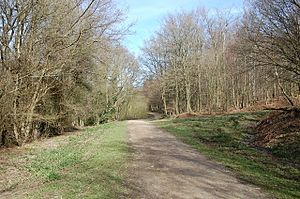Darwell Wood facts for kids
| Site of Special Scientific Interest | |
 |
|
| Area of Search | East Sussex |
|---|---|
| Interest | Biological |
| Area | 37.5 hectares (93 acres) |
| Notification | 1986 |
| Location map | Magic Map |
Darwell Wood is a special natural area in East Sussex, England. It covers about 37.5 hectares (93 acres). This makes it a Site of Special Scientific Interest, or SSSI. This means the area is protected because of its important plants and wildlife. You can find Darwell Wood north-west of the town of Battle.
Contents
Discovering Darwell Wood's Plants
Darwell Wood is home to many different types of plants. The trees and flowers here make it a great place for nature lovers. Let's explore some of the interesting plants you can find.
Trees and Woodlands
Most of Darwell Wood is covered by a type of forest called a coppice. Here, you'll find many hornbeam trees (Carpinus betulus). These trees are often cut back to the stump, which helps them grow new shoots. Taller oak trees (Quercus robur) also stand proudly above the hornbeams.
Underneath the thick tree canopy, the ground is mostly covered by soft mosses. You might also spot patches of pretty bluebells (Hyacinthoides nonscripta). Other common plants include blackberry bushes (Rubus fruticosus) and wood sorrel (Oxalis acetosella).
Higher Ground Plants
As you move to higher parts of the wood, the trees become more spread out. Here, you'll see silver birch trees (Betula pendula) and hazel bushes (Corylus avellana). There are also areas with sweet chestnut coppices (Castanea sativa).
The plants growing on the ground in these areas are different. You might find wood sage (Teucrium scorodonia), tall bracken ferns (Pteridium aquilinum), and sanicle (Sanicula europaea).
Chalky Soil and Special Flowers
On the western side of Darwell Wood, the soil is chalky. This type of soil is called calcareous. It helps certain plants grow well. Here, you'll find ash trees (Fraxinus excelsior).
Underneath the ash trees, you can see more mosses. Look out for ramsons (Allium ursinum), which are wild garlic plants. This area is also special because it has beautiful bee orchids (Ophrys apifera) and pyramidal orchids (Anacamptis pyramidalis). These are rare and lovely flowers.
Plants Along the Streams
Several streams flow through Darwell Wood. Over time, these streams have carved deep valleys into the rock. These valleys have steep sides. Along the streams, you'll find alder trees (Alnus glutinosa).
You might also see many grey willow trees (Salix cinerea) in some spots. The ground plants near the streams are different too. They include pendulous sedge (Carex pendula), water mint (Mentha aquatica), and opposite-leaved golden saxifrage (Chrysosplenium oppositifolium). Another pretty flower found here is ragged robin (Lychnis flos-cuculi).

